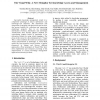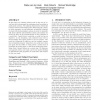55 search results - page 6 / 11 » Why Use a Unified Knowledge Representation |
ISMIS
1997
Springer
13 years 11 months ago
1997
Springer
e about image features can be expressed as a hierarchical structure called a Type Abstraction Hierarchy (TAH). TAHs can be generated automatically by clustering algorithms based on...
BMCBI
2007
13 years 7 months ago
2007
The bio-ontology community falls into two camps: first we have biology domain experts, who actually hold the knowledge we wish to capture in ontologies; second, we have ontology s...
HICSS
2009
IEEE
14 years 2 months ago
2009
IEEE
Successful knowledge management results in a competitive advantage in today’s information- and knowledge-rich industries. The elaboration and integration of emerging web-based t...
ATAL
2005
Springer
14 years 1 months ago
2005
Springer
In this paper we combine existing work in the area of social laws with a framework for reasoning about knowledge in multi-agent systems. The unifying framework in which this is do...
FOIS
2010
13 years 9 months ago
2010
Abstract. Taking for granted an ontological standpoint independent of any empirical or epistemological perspective, philosophical theories of properties are actually quite rarely a...


